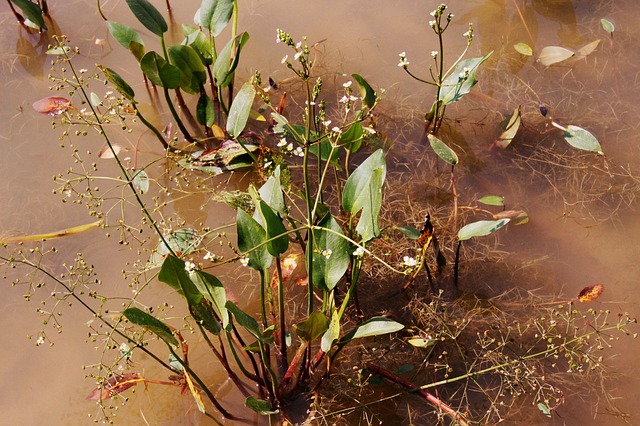 |  |  |   |  |
 |  |  |
Water plantain
is a perennial aquatic plant with a tuberous, fleshy root. The plant grows up to 55-70cm. Leaves on long petioles, leaf blades are crossed by strong veins, they form a root rosette of leaves. Leaf plates differ according to their location - below the water sheet, above the water sheet. Underwater leaves have developed aerial tissue. Above water leaves have long petioles and are elliptical in shape, underwater leaves are linear in shape. The stem is long and erect. During flowering, a spike with a long central axis and thin branches forms on the top of the flower stalk.
Water plantain
flower blooms in June-September. The flowers are small, pink or white, with three petals. Fruit - compound seed. Testes flattened, arranged in dense rings. Fruits also have air tissue, thanks to which they float on the surface of the water and are carried far away from the mother plant. The plant is pollinated by flies and orusids.
The rhizomes and leaves of the plant are used for medicinal purposes. The plant is known to be toxic when fresh, mainly to animals that eat it. By drying the plant, the juice also loses its toxicity. The plant is harvested in June-early August, the rhizomes are harvested in September-October. The rhizomes are dug, cleaned of soil and bark, then dried in the sun or in an oven not exceeding 50C. Further processing takes place by keeping the rhizomes in a salt or alcohol solution until they turn yellow. The leaves of the plant are dried in the shade. The drug is stored for 2 years in paper bags.
The chemical composition of
Water plantain
has been little studied, but it is known to contain 23% starch, essential oil, glucose, fructose, sucrose and resins. Lecithin, triterpenes (23-o-acetylalizol B, alizone A and B, alismol), choline are found in the rhizomes.
Medicinal significance
According to the results of European researchers, the triterpenes present in the
Water plantain
are antagonists, inhibitors of angiotensin receptor receptors. Therefore, the plant has a hypotensive effect, it should reduce increased pressure in the case of diseases of the excretory system, and also prevents the formation of calcium oxalates in the kidneys and ureters.
Medicinal products based on
Water plantain
have anti-inflammatory and antibacterial effects. American scientists have determined its effectiveness against pneumococcus, staphylococcus and mycobacteria. The herbal drug can be used for inflammation of the upper and lower respiratory tract and acute diarrhea.
Water plantain
reduces the amount of sugar and cholesterol in the blood.
Water plantain
has long been used in folk medicine, both as a preventive and as a treatment. A decoction of the leaves helps in chronic nephritis and edema of the kidneys. Women use decoctions of
Water plantain
to make the child refuse breastfeeding and stop lactation. A decoction of the roots is effective against the bites of mad dogs (rabies). Tibetans use
Water plantain
to treat hemorrhoids and STDs. Applications of fresh leaves help to heal non-healing wounds.
In Japan, a decoction of
Water plantain
is used as a strong diuretic, in cases of kidney and heart edema, hypertension, dizziness and other diseases.
Water plantain
is also useful in gynecology to reduce menstrual pain and regularize the cycle.
